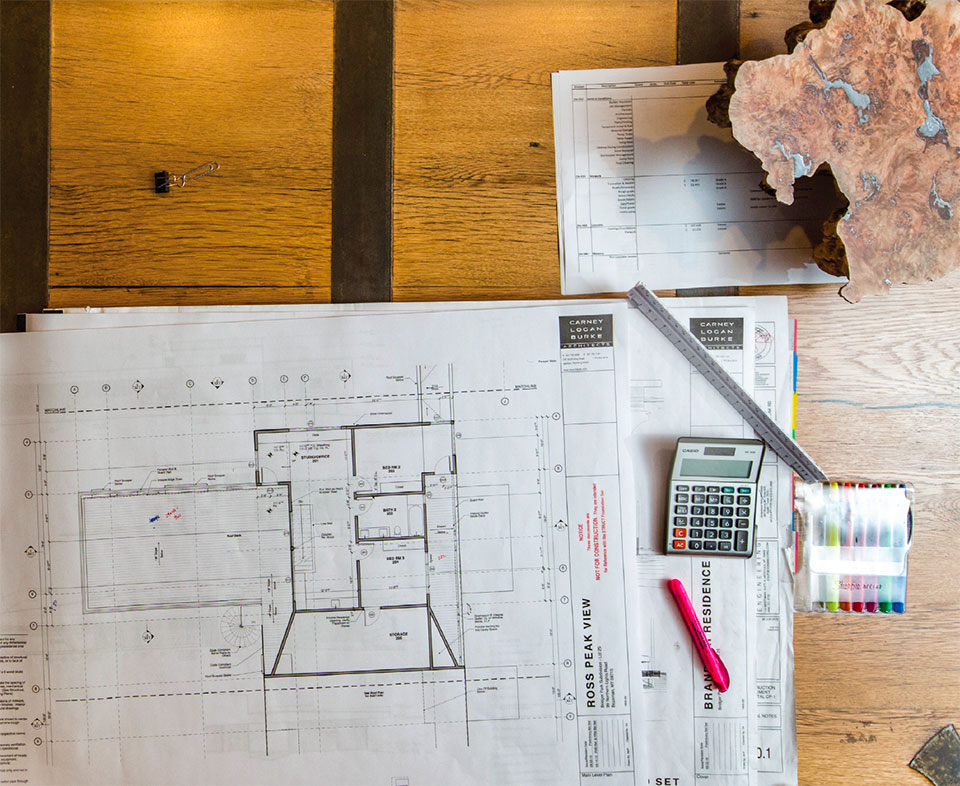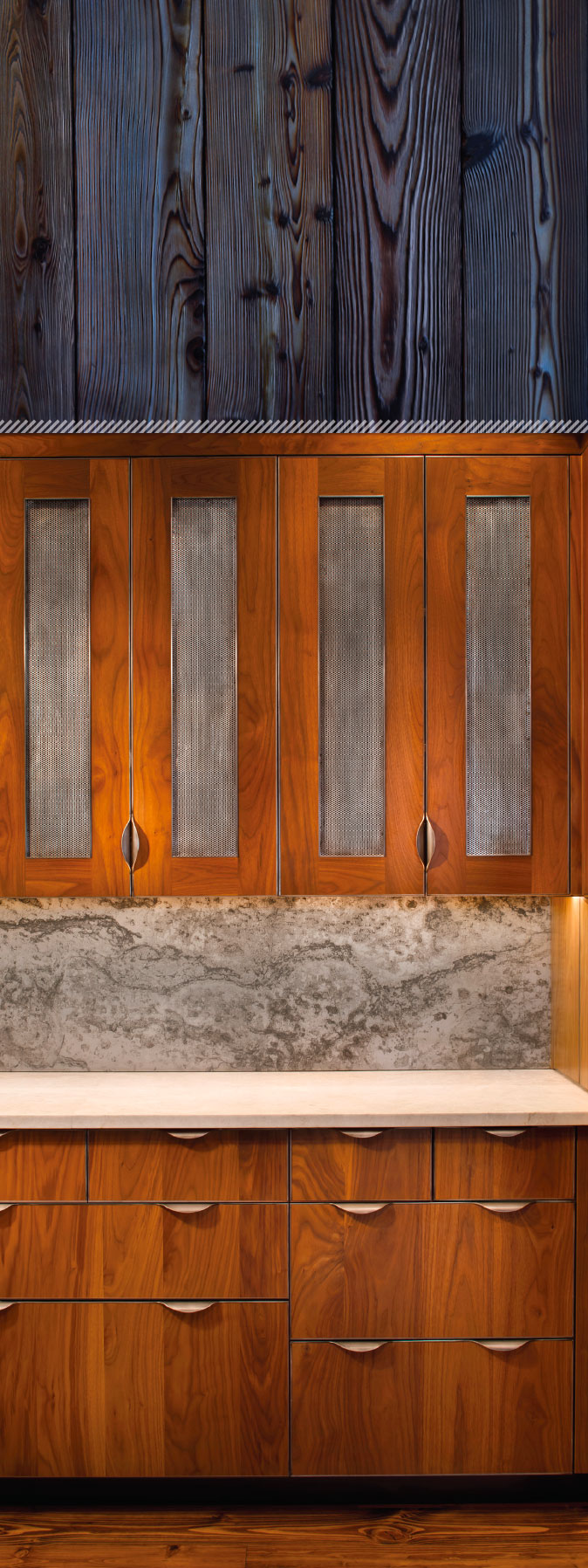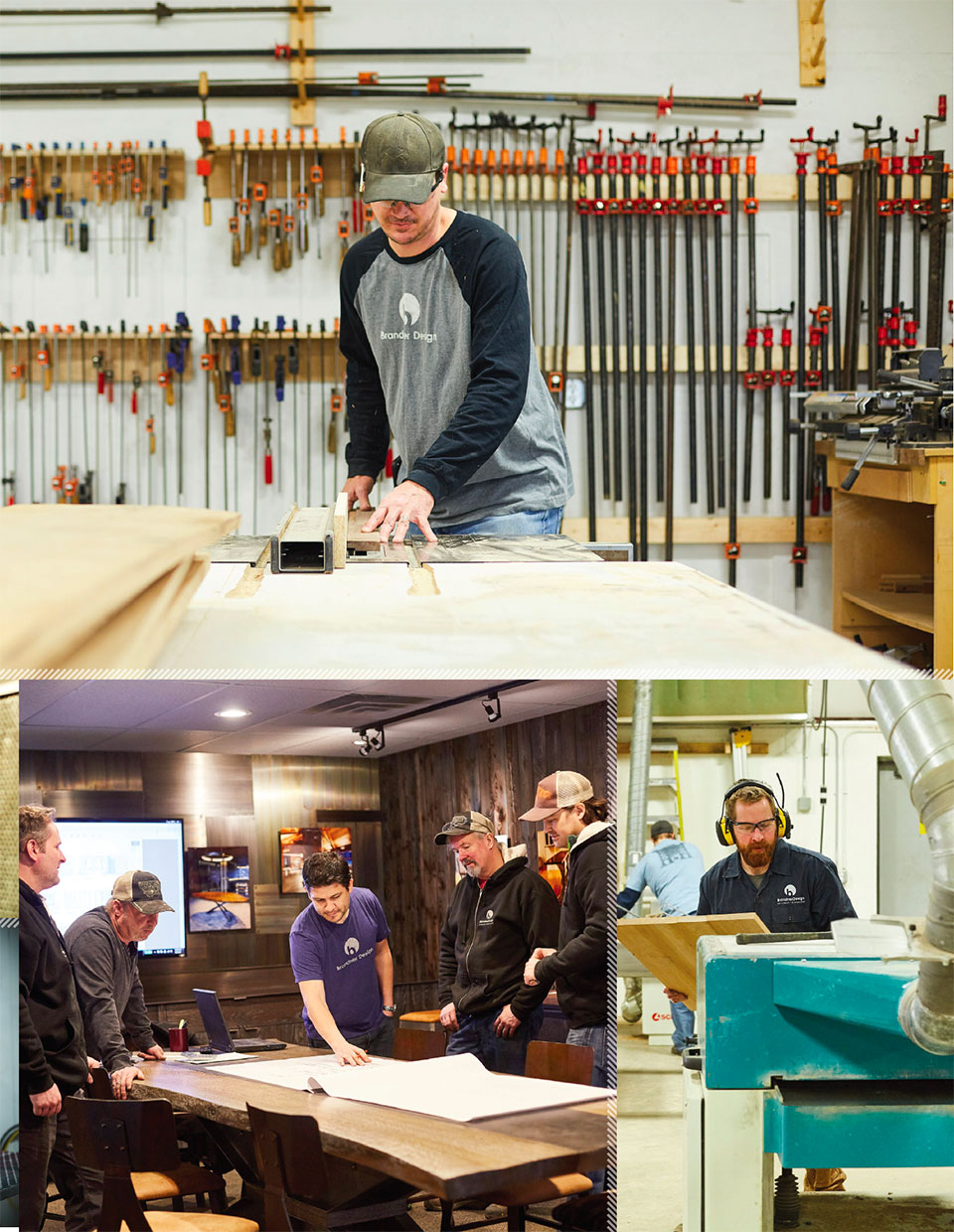BY Stephanie Dennee | PHOTOGRAPHY BY CODY BROWN
Wood is one of the oldest building materials in human history. From the first huts and human tools to contemporary design’s most prized creations, wood, as a material, is at the center. The appeal of timber products, in all their potential variations, endures today. A well-crafted wood piece lends timeless warmth and beauty to the heart of a home. From structural elements to fine furnishings to artisan details, spotlights how expert local craftsmen create with a medium that continues to take on new and relevant forms in our modern lives.
Artisan Furniture & Cabinetry
Woodland
“We make furniture for clients with very discerning tastes and an eye for beautiful work.”
–Lynn Harker, Woodland
As masters across a variety of crafted goods, Woodland’s product range includes everything from beautiful wood pieces to lighting to textiles to architectural details. But for the company’s owners, Lynn and Pat Harker, the intangible beauty of quality craftsmanship is the true medium with which they work. Lynn says that customers notice a difference in the finish-level of their products, even if they can’t find the words to explain it. “We work with many interior designers and architects who have the training and vocabulary to speak about a complex finish to a piece of wood or a particular furniture design, but a person untrained in design can still discern beauty,” he says. “When you see a piece that is perceptibly better, you just feel it. It creates an instantaneously elevated tone for the home.”
For the last two decades, Lynn and Pat have established Woodland as a force in the boutique furniture market, providing an elevated expression for homes throughout the country and internationally. Working directly with design professionals, builders, and select showrooms, they produce an extensive line of luxury home furniture and lighting. About the level of quality they create, Lynn says, “We make furniture for clients with very discerning tastes and an eye for beautiful work. Our products are crafted to meet and exceed those expectations.” Much of Woodland’s furniture is custom, meeting the luxurious scale and specifications of fine home design. Their pieces are all designed and built in-house, so Lynn and Pat can guide the quality carefully, and they pride themselves on reasonable lead times for their custom products.
Woodland has found success in the underserved segment of the home furnishing market that straddles the gap between mass-produced pieces with little in the way of finish customization and private local craftsmen with fewer capabilities. In the Goldilocks marketplace of the furniture industry, where the mass distributor is the “too big” and local shops are the “too small,” Woodland has carved a place for themselves as the “just right” source for custom furniture. Guided by Pat’s interior design background, Woodland is in tune to the needs of the boutique furniture buyer. “Design professionals utilize a very different set of resources for their clients than traditional furniture showrooms,” says Lynn. “We know how to meet their needs because we came directly from the world of interior design into furniture manufacturing.”
With the trends over the past few years leaning strongly toward transitional or contemporary design, clean lines and uncluttered details are sought-after. To meet that stylistic demand, developing rich and textured wood finishes in trending color tones has become a focus for Woodland. “Our finishes truly set us apart,” says Lynn. “Cerused oaks, refined wire-brushed walnut finishes with wax-highlighted grain patterns, and stone-looking casein paint finishes provide textural contrast to some of our standard, timeless stains and create visual interest on the transitional pieces we introduce at both Spring and Fall HighPoint markets. As always, attention to quality construction and details remains our top priority, regardless of the current design trends.”
It goes far beyond furniture for the Idaho Falls-based company. They are among only a few manufacturers of their caliber that also create custom cabinetry, millwork, and striking architectural details for their clients. This broadened skill set is indicative of the team’s holistic approach to design. As Lynn explains, “Furniture, millwork, and cabinetry all live in the same space, so they must complement each other. We understand the importance of that dynamic and provide this full range for homeowners’ projects so that their pieces will work seamlessly together to produce stunning results.”
A recent kitchen display typifies Woodland’s fine furniture bent toward the cabinetry market. The space is comprised of three different materials, visually breaking up the span of the wall in much the same way stand-alone furniture might, with each material accenting the next. A dark walnut range surround with scalloped corners is paired with clean white, inset cabinetry and a crowned hood range. The contemporary white cabinetry is complemented by cottage-chic, robin’s egg-hued integrated appliance panels. The overall effect is transitional and timeless.
Throughout the variety of products they create, Woodland’s focus on exceptional craftsmanship is what truly sets them apart in the design marketplace. This attention to detail and quality is what transforms functional furniture and cabinetry into the exquisite spaces of a home.
“Furniture, millwork, and cabinetry all live in the same space, so they must complement each other. We understand the importance of that dynamic.”
–Lynn Harker, Woodland
A Reverence for Reclaimed
Historic Woodworks
“The primary purpose of my design is to bring out the woods’ uniqueness. I want to do justice to the wood and justice to the history it represents. I want to give it another life as something beautiful.”
–Josh Weltman, Historic Woodworks
For Josh Weltman, reclaiming lumber is as much an act of preservation as it is woodwork. The reclaimed timber products and custom furniture he offers through his Tetonia-based Historic Woodworks are steeped in character, and expertly designed for function and beauty, but Josh explains that it goes much deeper than the look of the final product. “The primary purpose of my design is to bring out the woods’ uniqueness. I want to do justice to the wood and justice to the history it represents. I want to give it another life as something beautiful,” he says. It’s that sincere desire to preserve history through the re-purposing of wood that led Josh to the reclaimed lumber industry 20 years ago and, today, leads him to create striking, one-of-a-kind products.
Always drawn to shop class in school while growing up, Josh quickly took to a career in building cabinetry, pool tables, and doors. But he also never passed an old, leaning barn that he didn’t want to know the history of, so he spent a good deal of time studying American history as well. When he was tasked some 25 years ago to build cabinets out of reclaimed lumber, his two passions merged. It didn’t take long for him to give up his cabinetry job and strike out on his own with a ladder, a pry bar, and chainsaw. He began salvaging unusable structures throughout the area by hand. He jokes about his first years when reclaimed timber was still a relatively new market, “I knew what good reclaimed lumber looked like when I started out salvaging buildings. The rest I just figured out as I went.”
Josh’s Tetonia warehouse turned shop—a refurbishment project itself—is a far cry from his pry bar and chainsaw days. It houses state-of-the-art equipment for the salvage, dry storage, and fabrication of his reclaimed products, but Josh still holds the same reverence for wood. “There’s so much lost artistry and skill in the Old World carpentry that comes through our doors. It’s astounding to see the skill and time that went into these buildings by hand with axe-hewn timbers and rough-sawn siding. As we pull a thousand nails from boards, we can’t help but reflect on the time that went into the original buildings,” he says.
“Every piece of wood I use has a story.”
–Josh Weltman, Historic Woodworks
During the winter months, it can be difficult and expensive to source dry lumber. To keep costs down, Josh uses a 3,500-square-foot dry wood storage warehouse that enables him to stock 50,000 board feet of sorted reclaimed lumber. Home buyers have the luxury of seeing the wood, choosing what they want, and enjoying personal service with timely delivery and follow-up.
Beyond the sustainability, character, and sense of history that reclaimed lumber provides, Josh points to the low maintenance and stability of the product. “Part of the value of reclaimed materials is that they are already time-seasoned, and therefore more stable than new wood,” he says. Of the reclaimed exterior products Historic Woodworks offers, Josh adds, “For exterior applications, in particular, the maintenance of reclaimed lumber is very minimal, saving the homeowner time and money down the line.”
In addition to Historic Woodworks’ wide selection of exterior siding, the company can handle jobs of all sizes, ranging from custom one-off pieces to large commercial and residential projects. Josh builds many custom interior pieces including wall paneling, furniture, and cabinetry, flexing both his artistic capabilities and his breadth of experience. He says, “Custom pieces from reclaimed require a person with years of fabrication knowledge and a wealth of reclaimed lumber resources. It can be a tricky product to build with, so it’s critical to have that experience. When I’m contacted to build a piece, I’m able to take a client’s vision and advise them on the product that will get them the best result.”
In furniture fabrication, Josh balances rustic character with a smooth-to-touch appeal in pieces that range from tables to dressers to custom bar tops. Often, it’s through furniture that Josh works to preserve history, giving exceptional pieces of wood new life. “Every piece of wood I use has a story,” says Josh. His favorite stories are those that come full circle, be it taking down an old barn to make the owners custom furniture, or in some way reconnecting the reclaimed wood to its source. “I had a stock of turn-of-the-century pickle wood that was salvaged from the Dreher Pickle Factory in Colorado. Somehow, the descendants of the Dreher family tracked me down and I was able to make a series of cribbage boards for the family from that wood,” he says. In recounting this story, Josh’s passion for reclaimed wood is clear. He loves the history and the wood itself. He adds, “Projects like that are proof for me that I’m doing what I’m meant to do.
“When first moving to the area I decided that if I was going to make my life here I needed to make a living but not compromise my values. I’d need to make a living while still contributing to the development of our location in a positive way. Now, as I look at the extensive amount of work I’ve done in both valleys, I’m proud of the history I’ve helped preserve and the positive impact I’ve helped create in the landscape,” says Josh.
Creating Balance
Brandner Design
“What I do now is just an extension of painting and sculpture.”
–Jeff Brandner, Brandner Design
Designing in the West offers a certain latitude of expression. The region is not locked in by a rigid framework from past styles, and thus it offers a melting pot for new ideas. Artist Jeff Brandner moved from the East Coast to Bozeman in 2005, in part, because of this freedom. He brought an appreciation of industrial steel forms from his Pennsylvania roots, and a keen eye for the craftsmanship he saw in the colonial home where he grew up. His success in cabinetry, custom furniture, and architectural installations now blurs the line of his career between craftsman and fine artist, and what he accomplishes can, on multiple levels, be described as finding balance in a wide-open field of design.
A balance of materials is the first and most easily spotted standard of Brandner Design’s work. Jeff and his Bozeman-based team of 35 regularly combine wood with steel and other materials. For Jeff, who studied oil painting and sculpture, the balanced integration of wood and metal begins with an artist’s eye for composition. He says, “What I do now is just an extension of painting and sculpture. The treatments we create for steel and wood are intended to do more than finish and protect the material. We aim to create movement and depth in our wood finishes and metal patinas, and our materials relate to each other when combined. We want everything we build to have a sense of fine art.”
When refining wood finish techniques, the Brandner team often looks to the past before pointing to the future. The centuries-old burn finish Shou Sugi Ban is one technique that Brandner regularly uses, and has successfully modified. He adds ink stains to the process to bring color and an iridescent quality to the finished product. Cerusing, a technique first made popular in America through Art Deco design, is also made new again in Brandner’s hands. Originally, a white, lead-based pigment was used to create the grain-enhancing treatment. Brander uses a safer polymer treatment and experiments with the addition of various pigments and wire-brush techniques to develop character in the wood. The Brandner team even bakes their wood in 400º ovens to create color and depth without a single drop of pigment.
“What we build must work well for the client. That’s a given, But we try to push beyond that. We want to touch their senses, not just fulfill a need.”
–Jeff Brandner, Brandner Design
Most exciting for Jeff is his new technique for the metallic finishing of wood. For this process, an alloy mix is baked on to the material, filling the knots and grooves of the wood. “What you end up with is a metallic wood,” says Brandner. “We love to mix wood and metal. This finish is as close as you can get to a perfect melding of the two.” The final look can be a bit ambiguous, even mystifying. “People walk up to it and ask, ‘Is that wood or metal?’ That’s a real compliment to us. We want people to interact with our work and have an emotional response.”
A blending and balancing of styles—modern design mixed with industrial materials, traditional pieces in new finishes—is another line drawn through Brandner’s work. Jeff credits his clients when asked about this, saying, “People are moving here from different parts of the country. They bring styles they know and love from where they’ve come. In our process, we blend and refine those, paying homage to multiple design principals to create a new style.”
For any fabricator, a balance of form and function is a baseline expectation. “What we build must work well for the client. That’s a given,” Jeff says. “But we try to push beyond that. We want to touch their senses, not just fulfill a need.” This balance is accomplished through an exploration of new materials and techniques. “When clients ask us to do things that are new, it’s a great opportunity for us to explore. Sometimes we don’t know exactly how to accomplish a client’s vision at the start. We just have to dig in and figure it out. Often, the solution we come to is better than what we originally imagined it could be. It’s a constant evolution of our work from project to project.” The process of digging in and figuring it out is also quite representative of the wide-open West, a place that Brandner Designs celebrates and continues to discover through their craft.
A Custom Collaboration
Rusty Nail
“We have customers come in, who have spent years looking at an empty space in their home because they haven’t been able to find the right size or style of furniture for it.”
–Teneal Neihart, The Rusty Nail
On a hopeful hunch, woodworker Jake Bradshaw took one of his hand-hewn aspen bed frames to interior designer Teneal Neihart’s The Rusty Nail showroom in the Teton Valley to see if she’d be interested in adding it to her collection. She loved the design and agreed to place it on her floor. When it sold within a week, and the buyers asked Jake to build a matching dresser and nightstands, an exclusive partnership was born. Ten years later, Jake has created hundreds of custom furniture pieces, cabinetry, and architectural accents with Teneal for the Jackson area and throughout the country. The collaboration continues as they design and produce one-of-a-kind wows for every room of the home.
Jake has always been a maker. Growing up on a farm near Rexburg, there were plenty of things to be built or fixed, and after he finished school, he joined his brother’s construction business where he honed his skills in finish work and cabinetry. But when asked about his design prowess and ability to blend materials—wood with metal, leather, upholstery—he credits his father, saying, “I can trace a lot of my skill back to my dad, who makes custom saddles. We would build saddle trees together, then shape the rawhide, carve, and tool the saddle. I absorbed a lot of my ability to craft fine details from his saddle making.”
Working with a combination of materials is a signature of Jake’s wood fabrication, mixing reclaimed wood with new hardwoods, and adding leather and metal into the design. For a private library, Jake created custom shelving with both reclaimed lumber and rustic-finished alder. He then integrated oxblood-hued leather and metal to the back of the shelves, yielding interest from shelf to shelf. For a bar area, a custom wall of reclaimed lumber uses mixed board widths and wood tones. Of mixing materials, Jake says, “Creating variation in the material gives an additional layer of character and warmth to the room.” The bar itself features the same reclaimed detail below but is fit with a thick, contemporary live-edge slab top. Custom honey-hued cabinetry with glass fronts completes the inviting social space.
Design is a team endeavor at The Rusty Nail, where Teneal and fellow designer Cyndi Friend pull together Jake’s work within the context of all the elements that the full-service design shop curates for their clients. “We have a great back and forth when designing,” Teneal says. “Cyndi and I bring the client’s vision to the table, Jake offers a lot of fabrication knowledge, and together we relate how the final piece will work with all the furniture chosen. We’ve forged life-long relationships with many of our clients, so we can really focus on a client’s aesthetic.”
The cultivation of great client relationships leads one project to the next for The Rusty Nail and Jake. One piece of custom furniture will result in a call to do a full room, even a full house in some instances. Jake says, “We’ve done some great whole-house projects recently, with custom installations for almost every room. It’s a fantastic opportunity to take a client’s style and adapt that from room to room, making each space unique.”
“I’m hard-pressed to give an example of a piece of furniture I’ve built exactly the same way twice.”
–Jake Bradshaw, Woodworker
Jake says, “I’m hard-pressed to give an example of a piece of furniture I’ve built exactly the same way twice.” He finds that making truly custom furniture keeps him engaged and ready to meet the next design challenge. This is to the benefit of their clientele, many of whom might not have considered a custom furniture experience until they walked through the showroom door. Teneal explains, “We have customers come in who have spent years looking at an empty space in their home because they haven’t been able to find the right size or style of furniture for it. We’ll hear from them that if they had known it could be this easy to have a beautiful piece custom made for them—and locally—they would have done it years ago. Our clients don’t have to settle for furniture purchased online that’s four inches too short, or not quite the right finish or style. We give them exactly what they’ve always wanted for their space.” In the tenth year of this rewarding design-build collaboration, The Rusty Nail is excited to be moving to a new showroom space in downtown Driggs, where their talented team will continue to turn those never-thoughts into exact-wants.















